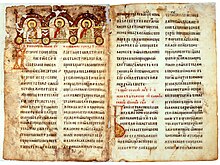Serbs in Montenegro

Miroslav Gospel, one of the oldest surviving documents written in Serbian recension of Church Slavonic, was created by order by Miroslav of Hum
|
|
| Total population | |
|---|---|
| 178,110 (2011) | |
| Languages | |
| Serbian | |
| Religion | |
| Serbian Orthodox Church | |
| Related ethnic groups | |
| Montenegrins |
Serbs of Montenegro (Serbian: Srbi u Crnoj Gori / Срби у Црној Гори) or Montenegrin Serbs (Serbian: Crnogorski Srbi / Црногорcки Cрби) , compose the second largest ethnic group in Montenegro (28.7% of country's population), after the Montenegrins. In historiography, the Orthodox people of Montenegro were called Serbs. In the constitutions of the Principality of Montenegro and Kingdom of Montenegro, the Montenegrin people's ethnonym was Serbs. With the formation of Socialist Yugoslavia, the censuses showed a majority of people declaring as Montenegrins.
Following the Slavic settlement of the Balkans in the 6th and 7th centuries, several principalities were established in the Western Balkans towards the Adriatic. Duklja, first mentioned in the De Administrando Imperio (c. 960), was one of the Serbian principalities that came under Byzantine rule in 1018 after Basil II's conquest of Bulgaria. The Serbs were the Empire's "most important but insubodinate subjects in the western Balkans". Duklja broke away from Byzantine rule in 1042 under ruler Stefan Vojislav and became the leading Serbian state until the 12th century. All of what is today Montenegro came under the rule of Grand Prince Stefan Nemanja, the founder of the Nemanjić dynasty, after 1180. Zeta, formerly known as Duklja, became a less important region in the Serbian state. Nevertheless, it remained a crown land, given to the heir of the monarch. Several monasteries date to this period, such as: Praskvica, Banja, Morača, Vranjina, and others.
...
Wikipedia
